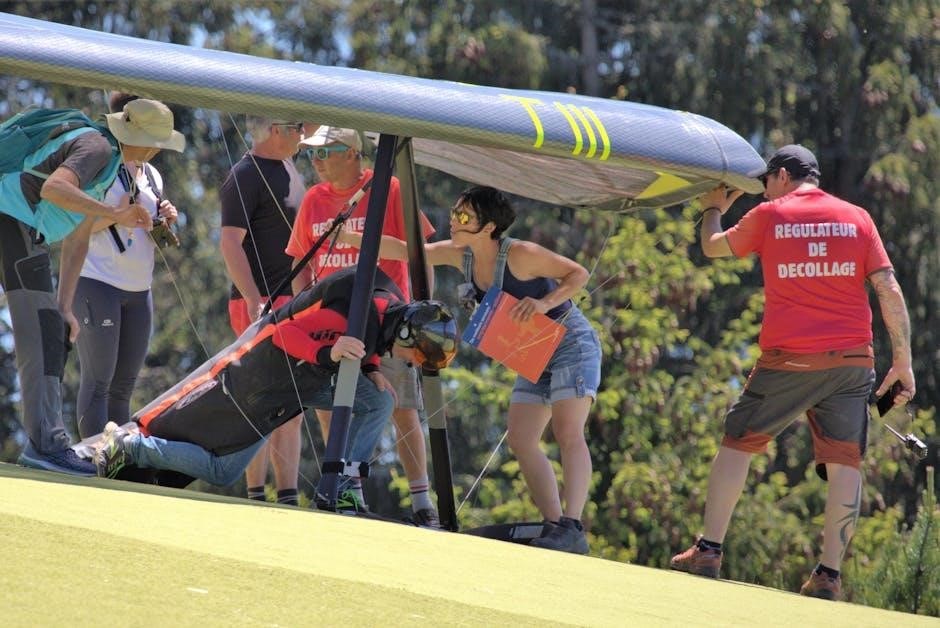
The BLS Instructor Manual is an essential resource for instructors, offering updated 2020 guidelines and a comprehensive framework for teaching life-saving techniques effectively today.
Overview of the BLS Instructor Manual
The BLS Instructor Manual serves as a comprehensive guide for teaching the American Heart Association’s Basic Life Support (BLS) course. It provides instructors with updated 2020 guidelines, lesson plans, and resources to deliver effective training. The manual includes detailed instructions for both Instructor-Led Training (ILT) and blended-learning formats, ensuring flexibility for diverse teaching environments. Available in both print and digital formats, it offers convenience and accessibility. Instructors can rely on this manual to cover core content, including CPR techniques, use of AEDs, and team dynamics in emergency situations. It is an indispensable tool for ensuring that students are well-prepared to perform lifesaving skills confidently and correctly.
Importance of the BLS Instructor Manual
The BLS Instructor Manual is a critical resource for ensuring that instructors deliver high-quality training in line with the American Heart Association’s standards. It provides a standardized framework for teaching life-saving skills, ensuring consistency across all training sessions. By adhering to the most current guidelines, instructors can equip students with evidence-based practices that improve patient outcomes. The manual’s structured approach ensures that no vital information is overlooked, making it indispensable for both new and experienced instructors. Its importance lies in its ability to empower instructors to confidently and effectively teach lifesaving techniques, ultimately contributing to better community preparedness and response to emergencies.
Target Audience for the BLS Instructor Manual
The BLS Instructor Manual is primarily designed for certified American Heart Association (AHA) BLS Instructors who teach life-saving techniques to healthcare professionals and lay responders. It is also beneficial for new instructors seeking to align their teaching methods with updated guidelines. Additionally, the manual serves as a reference for healthcare educators, EMS trainers, and professionals involved in CPR and emergency cardiovascular care (ECC) training. The content is tailored to ensure instructors can effectively deliver both Instructor-Led Training (ILT) and blended-learning courses, making it an invaluable resource for anyone responsible for teaching BLS skills and staying current with 2020 AHA guidelines.

Key Features of the BLS Instructor Manual
The BLS Instructor Manual includes updated 2020 guidelines, detailed lesson plans, teaching strategies, and visual aids to support effective instruction. It is available in both digital and print formats.
Content Overview
The BLS Instructor Manual provides a comprehensive framework for teaching life-saving skills, aligned with the 2020 American Heart Association guidelines. It includes detailed lesson plans, teaching strategies, and visual aids to support instructors in delivering effective training. The manual covers essential topics such as CPR techniques, use of AEDs, and rescue breathing, ensuring instructors are well-prepared to train healthcare professionals. Additionally, it offers resources for both instructor-led training (ILT) and blended-learning formats, making it versatile for various educational settings. The content is structured to promote engagement and mastery of critical skills, ensuring high-quality training outcomes. It is a vital tool for BLS instructors.
2020 Updates and Guidelines
The 2020 updates in the BLS Instructor Manual reflect the latest advancements in cardiopulmonary resuscitation (CPR) and emergency cardiovascular care (ECC). These updates align with the American Heart Association’s (AHA) new guidelines, emphasizing improved techniques for chest compressions, rescue breathing, and the use of automated external defibrillators (AEDs). The manual incorporates evidence-based practices to enhance training effectiveness and student outcomes. Instructors will find revised lesson plans and teaching strategies that prioritize hands-on practice and scenario-based learning. The updates ensure that instructors are equipped to teach the most current and effective life-saving skills, making the BLS Instructor Manual indispensable for modern training environments.
Digital vs. Print Versions
The BLS Instructor Manual is available in both digital and print formats, catering to different preferences and needs. The digital version (eBook) offers convenience and accessibility, allowing instructors to access content on various devices. It includes the same essential information as the print version but provides enhanced portability and search functionality. The print version remains a popular choice for those who prefer a physical copy for easy reference during training sessions. Both formats are updated with the 2020 guidelines, ensuring instructors have the most current information. The AHA recommends choosing the format that best suits individual teaching styles and environments.

Structure of the BLS Instructor Manual
The manual is logically organized into chapters, starting with foundational concepts and progressing to advanced techniques, ensuring a comprehensive approach to BLS training and instruction.
Chapter Breakdown
The BLS Instructor Manual is divided into clear chapters, each focusing on specific aspects of BLS training. The first chapters cover foundational concepts, such as the role of BLS instructors and the science behind lifesaving techniques. Subsequent chapters delve into detailed lesson plans, teaching strategies, and hands-on training methods. Additional sections provide resources for scenario-based learning and troubleshooting common challenges. Each chapter is designed to build sequentially, ensuring instructors gain comprehensive knowledge and skills to effectively teach BLS courses. The manual also includes updates from the 2020 guidelines, reflecting the latest in CPR and emergency care practices. This structured approach ensures instructors are well-prepared to train others in critical lifesaving skills.
Lesson Plans and Teaching Strategies

The BLS Instructor Manual provides detailed lesson plans and evidence-based teaching strategies to ensure effective knowledge transfer. These plans are designed for both instructor-led training (ILT) and blended-learning formats, aligning with the 2020 guidelines. Instructors can use these structured plans to deliver courses efficiently, covering topics such as CPR techniques, AED use, and rescue breathing. The manual emphasizes hands-on practice and scenario-based learning to reinforce skills. Additional resources, including visual aids and practice exercises, are included to engage students and promote retention. By following these strategies, instructors can create dynamic and interactive learning environments, ensuring students master critical lifesaving skills. This approach supports both novice and experienced instructors in delivering high-quality training.
Visual Aids and Resources
The BLS Instructor Manual is complemented by a range of visual aids and resources to enhance teaching effectiveness. These include high-quality images, diagrams, and instructional videos that demonstrate proper techniques for CPR, AED use, and other lifesaving skills. Instructors can access additional materials, such as training DVDs and online resources, to support their lessons. The manual also directs users to the AHA Instructor Network, where tutorial videos and practice exercises are available. These resources help instructors create engaging and interactive learning experiences, ensuring students gain both theoretical knowledge and practical proficiency in BLS skills. The integration of visual and interactive elements makes complex concepts easier to understand and apply.

Becoming a BLS Instructor
To become a certified BLS Instructor, candidates must complete the BLS Provider Manual, pass the BLS Instructor Essentials course, and demonstrate proficiency in teaching lifesaving skills effectively.
Prerequisites for Instructor Candidates
To become a certified BLS Instructor, candidates must meet specific requirements. They must hold a current BLS Provider certification and complete the BLS Instructor Essentials online course. Additionally, candidates are required to bring their BLS Instructor Manual and course completion certificates to the training session. Prior experience in teaching or healthcare is highly recommended, though not always mandatory. Candidates must also demonstrate proficiency in CPR skills and familiarity with the latest AHA guidelines. These prerequisites ensure that instructor candidates are well-prepared to effectively teach lifesaving techniques and meet the standards set by the American Heart Association. Proper preparation is crucial for success in the certification process.
Training and Certification Process
The BLS Instructor certification process involves a structured approach to ensure proficiency. Candidates must complete the BLS Instructor Essentials online course, which covers core content and teaching strategies. Following this, they attend an in-person training session led by experienced AHA instructors. During this session, candidates participate in hands-on training, demonstrate their CPR skills, and deliver teaching scenarios. A written exam must also be passed to confirm understanding of the material. Upon successful completion, candidates receive their BLS Instructor certification, enabling them to teach AHA-accredited courses. The process ensures instructors are well-equipped to deliver life-saving training effectively, aligning with the latest AHA guidelines and standards.
Application and Course Enrollment
To enroll in the BLS Instructor course, candidates must first submit an application through the American Heart Association (AHA) website or an approved training center. The process requires proof of current BLS Provider certification and completion of the BLS Instructor Essentials online course (product code 20-3103). Candidates must also purchase the BLS Instructor Manual (eBook ISBN 978-1-61669-800-3 or print ISBN 978-1-61669-769-3). Upon acceptance, students receive access to the course materials and schedule their in-person training session. Proper documentation, including the Instructor Essentials completion certificate, must be presented at the start of the course. This ensures eligibility to proceed with the certification process.

Teaching Methods and Techniques
The BLS Instructor Manual provides updated 2020 guidelines and a comprehensive framework for teaching life-saving techniques. It includes instructor-led training, hands-on practice, and scenario-based learning to ensure effective knowledge application.
Classroom vs. Blended Learning
The BLS Instructor Manual supports both classroom-based and blended-learning formats, offering flexibility for instructors. Classroom learning provides hands-on training and immediate feedback, while blended learning combines online instruction with in-person skill practice. The manual includes lesson plans for both methods, ensuring consistency and adherence to 2020 guidelines. Instructors can choose the approach that best fits their students’ needs, whether through traditional in-person sessions or a mix of digital and practical training. This dual approach ensures comprehensive understanding and retention of life-saving skills, catering to diverse learning preferences and environments. Both methods emphasize active participation and real-world application of BLS techniques.
Hands-On Training and Practice
Hands-on training is a cornerstone of the BLS Instructor Manual, emphasizing practical skill mastery. Instructors guide students through simulations, such as CPR and AED use, ensuring proficiency. The manual provides detailed scenarios and exercises to reinforce learning. Students engage in realistic emergency simulations, applying techniques like chest compressions and rescue breaths. This immersive approach aligns with 2020 guidelines, ensuring skills are performed correctly. The manual also includes tips for instructors to provide constructive feedback, enhancing retention; By combining theory with practice, hands-on training ensures students are prepared to respond confidently in real-life situations, making it a critical component of BLS instruction.
Scenario-Based Learning
Scenario-based learning is a key component of the BLS Instructor Manual, allowing students to apply knowledge in realistic emergency simulations. These scenarios mimic actual cardiac arrests, choking incidents, and other life-threatening situations, helping students develop decision-making skills. Instructors guide participants through dynamic exercises, encouraging teamwork and quick thinking. The manual provides diverse scenarios to cover various emergencies, ensuring comprehensive preparation. By practicing in simulated environments, students build confidence and proficiency in performing CPR, using AEDs, and coordinating care. This approach aligns with the 2020 guidelines, emphasizing practical application and real-world readiness. Scenario-based learning bridges theory and practice, enhancing overall training effectiveness.

Troubleshooting Common Challenges
The BLS Instructor Manual addresses common challenges, offering solutions for technical issues, student engagement, and practical application difficulties, ensuring effective training outcomes.
Addressing Student Questions
The BLS Instructor Manual emphasizes the importance of addressing student questions effectively to ensure understanding and retention of life-saving skills. Instructors are encouraged to create an open, interactive environment where students feel comfortable asking questions. The manual provides structured lesson plans and visual aids to help instructors address common queries. Additionally, it offers tips on how to handle difficult or repetitive questions, ensuring clarity and precision. By leveraging the manual’s resources, instructors can deliver comprehensive explanations, reinforcing key concepts and promoting confident learning. This approach aligns with the American Heart Association’s commitment to high-quality training and effective knowledge transfer.
Managing Classroom Dynamics

The BLS Instructor Manual provides strategies to effectively manage classroom dynamics, ensuring a productive and engaging learning environment. Instructors are encouraged to foster a positive atmosphere, promoting active participation and respectful interaction among students. The manual suggests techniques to handle diverse learning styles and maintain focus. It also offers guidance on managing challenging behaviors and ensuring all students feel included. By leveraging the manual’s structured lesson plans and interactive resources, instructors can create a balanced and dynamic classroom setting. This approach supports the American Heart Association’s goal of delivering high-quality training, ensuring students are well-prepared to apply their skills in real-world scenarios.
Technical Issues and Solutions
The BLS Instructor Manual addresses common technical challenges, providing practical solutions to ensure smooth delivery of training. Instructors may encounter issues such as connectivity problems when accessing digital materials or difficulty navigating the eLearning platform. The manual recommends ensuring a stable internet connection and using compatible devices. Additionally, troubleshooting guides are available to resolve issues like corrupted files or incomplete downloads. The American Heart Association also offers technical support for instructors facing difficulties. By being prepared for potential technical hiccups, instructors can minimize disruptions and maintain an effective learning environment for their students. Proper planning and backup resources are key to managing these challenges successfully.

Industry Reception and Reviews
The BLS Instructor Manual has received positive feedback from healthcare professionals, praised for its clarity and updated guidelines. It is widely adopted as a standard resource.
Feedback from Healthcare Professionals
Healthcare professionals have praised the BLS Instructor Manual for its clarity and comprehensive updates, particularly the 2020 guidelines. Many instructors appreciate the structured lesson plans and teaching strategies, which enhance the delivery of life-saving skills. The manual’s emphasis on evidence-based practices has been highlighted as a key strength, ensuring that instructors are well-equipped to train others effectively. Additionally, the inclusion of digital resources has been well-received, offering flexibility for modern teaching environments. Overall, the manual is widely regarded as an essential tool for BLS training, supporting both instructors and learners in achieving certification and mastery of critical skills.
Institutional Adoption and Recommendations
The BLS Instructor Manual has been widely adopted by healthcare institutions due to its comprehensive updates and alignment with the latest 2020 guidelines. Many organizations recommend it as a primary resource for training programs, citing its clear structure and practical lesson plans. The manual’s digital version has been particularly praised for its accessibility, allowing instructors to integrate it seamlessly into blended-learning environments. Institutions also appreciate the inclusion of scenario-based learning tools, which enhance student engagement and preparedness. The AHA’s commitment to evidence-based training has made this manual a cornerstone for BLS certification programs worldwide, ensuring consistent and high-quality education.
Comparisons with Previous Editions
The BLS Instructor Manual has evolved significantly, with the 2020 edition incorporating the latest CPR and ECC guidelines. Compared to earlier versions, such as the 2015 edition, the updated manual reflects advancements in life-saving techniques and training methodologies. The 2020 version includes expanded lesson plans, scenario-based learning, and digital enhancements, making it more comprehensive and accessible. Previous editions, like the 2010 guidelines, have been retired, ensuring instructors align with current best practices. The updated structure and content of the 2020 manual provide a more engaging and effective framework for teaching BLS skills, addressing the needs of modern healthcare professionals and educators.
The BLS Instructor Manual serves as an essential guide, aligning instructors with updated life-saving practices and enhancing their ability to teach critical skills effectively and confidently.
Final Thoughts on the BLS Instructor Manual
The BLS Instructor Manual is a comprehensive resource that equips instructors with the latest guidelines and teaching strategies to deliver effective life-saving training. Updated with the 2020 standards, it ensures instructors are well-prepared to teach both classroom and blended-learning formats. The manual’s clear structure, combined with its digital and print options, offers flexibility for modern educators. By aligning with the American Heart Association’s mission, it emphasizes the importance of high-quality training in saving lives. Instructors rely on this manual to stay current and confident in their teaching, making it an indispensable tool for fostering proficiency in CPR and emergency care skills.

Future Directions and Updates
The BLS Instructor Manual is expected to evolve with advancements in medical research and training methodologies. The American Heart Association (AHA) typically updates its guidelines every five years, ensuring the manual remains aligned with the latest scientific consensus. Future editions may incorporate more interactive digital features, such as enhanced visuals or virtual simulations, to enhance teaching and learning experiences. The transition to digital formats is likely to continue, offering greater accessibility and easier updates. Instructors should stay informed about these updates through the AHA’s official channels to maintain compliance and deliver the most current training. Regular updates ensure the manual remains a vital resource for lifesaving education.
Encouragement for Continuous Learning
The BLS Instructor Manual emphasizes the importance of ongoing education and professional development for instructors. Staying updated with the latest guidelines and teaching methods is crucial to delivering effective training. Instructors are encouraged to regularly review updates, participate in workshops, and engage with the American Heart Association’s resources, such as webinars and online courses. Continuous learning ensures instructors remain proficient in teaching lifesaving skills and adapts to evolving medical practices. By committing to lifelong learning, instructors can inspire confidence in their students and contribute to the mission of saving lives. This dedication fosters a culture of excellence in BLS training and beyond.